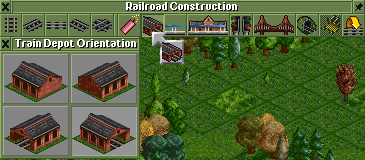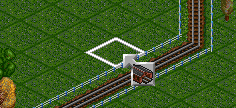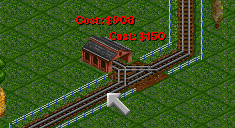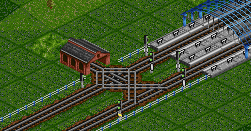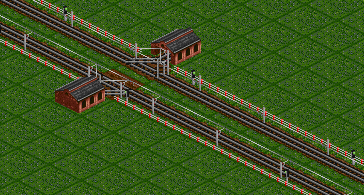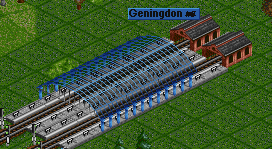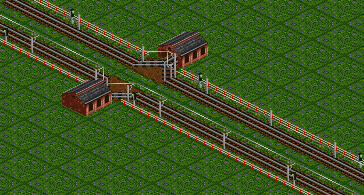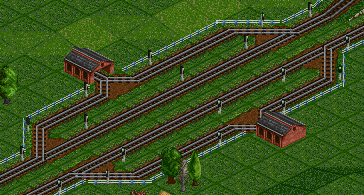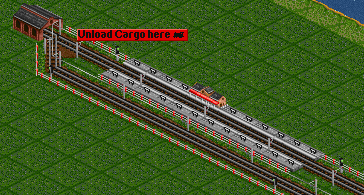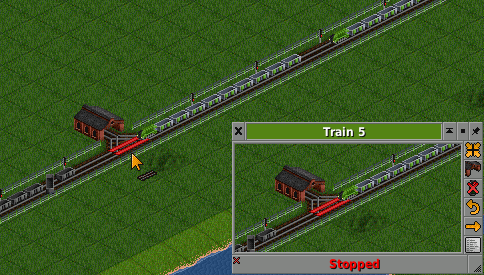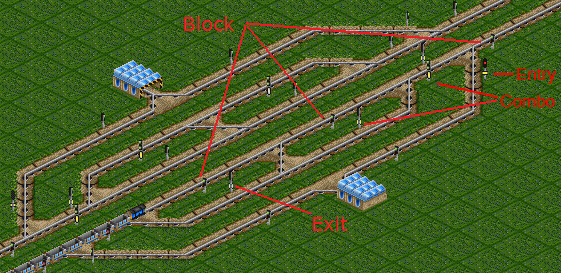Basic tutorial:
Advanced railway tutorial:
In game tutorial:
Railway construction: Road construction: Waterways construction: Airport construction: General construction: Working with vehicles:
This page describes only railway depots. There are also depots for the other transport types.
In this tutorial, you will learn how to build (place, position) depots so they align with your tracks. Depots are where you build new trains and service existing trains, so make sure trains can both enter and exit depots.
Contents |
How do I place a depot?
-
Click the railway build button
 on the menu bar to display the railway construction toolbar:
on the menu bar to display the railway construction toolbar:
-
Click on new depot button or press "7". The Train Depot Orientation window opens.
-
Select the direction you want your depot to face. This determines how trains enter and exit the depot.
-
Place the depot next to your tracks, orientating the exit towards the tracks. Besides building on flat land you can also Build on slopes.
-
Once you are happy with the position, click to place the depot. If there are rails adjacent to the depot, additional tracks will be placed automatically.
Remember, you can always destroy your depot with the dynamite tool  .
.
Where should I place a depot?
Where to place a depot is a strategic decision completely up to you. You can always just stick couple of depots on your lines and hope for the best  .
.
You should make sure that trains:
- Can be serviced effectively;
- Will not cause traffic jams when being serviced.
There are a few strategies for achieving this:
-
Service trains at specified time intervals or add depots into the train's orders list. Depots can be added to the train's orders in the same way as stations and waypoints.
-
Build rails in such a way that trains are forced to enter a depot each time they pass through a station or track.
There are also other advanced depot configurations that solve some issues that affect the configurations described above.
The most common problems related to depots are:
- Fast trains slow down when they enter or exit a depot which also slows down other incoming trains. This can lead to traffic jams in a crowded rail network.
- Sharp corners near depots slow down trains.
- If traffic is heavy, trains can 'accumulate' in depots and stay there for a long time. For example, if a depot is located at the end of a station and contains a train, a new train can enter the station on the same line, blocking the first train from leaving the depot. Multiple trains can end up being blocked inside a depot.
Advanced depot configurations
-
Depots on both lines: This configuration allows the trains to accelerate when entering/exiting a depot without slowing down other trains running on the main lines:
-
Forced service: It often makes sense to service a train after delivering cargo or right before loading new cargo. This is because income depends on the total time that elapses between the cargo being loaded and being delivered. You may want to service the train before loading cargo, and then not service it again until the cargo has been delivered.
Example of forced service after delivering the cargo:
Other advantages for this configuration:
- Needs minimal space
- Fast and long trains are only slowed down once for both servicing and passing through the station.
- Avoids sharp turns by using the 'depot trick' to turn vehicles around 180 degrees
- Overflow depot: Place a depot at the entrance of a Ro-Ro loading station, so that the only way to the platforms goes through the depot. Instead of queuing up before the entrance, empty trains enter the depot and wait there.

Trains waiting in the depot until there is a free platform. Note the path signal in front of the depot entrance.
- Emergency overflow depot: An accidental blockage of the track (due to a crash or a disaster) can make the trains queue up. To avoid traffic jams further up the line, build a temporary forced depot to house additional incoming trains. Once the blockage is cleared, trains will automatically exit the depot and continue to their destinations. You may need to remove signals or a piece of track to make room for the depot.
- Right-of-way depots: Trains exiting depots move much slower than trains traveling on the main lines. With Signals, you can make trains exiting the depot wait for trains on the main line to pass. It is a good idea to understand pre-signals if you want to understand HOW and WHY this works.
|
This layout creates a pre-signal chain running backwards along your track. In the picture, a train on the main line has made the grey exit pre-signal red. The red exit pre-signal communicates to the combo pre-signals, and turn them red. The entry pre-signal is red because its only exit pre-signal is red.
Splitting your tracks into 2 or more tracks before servicing is useful if traffic is heavy. Because trains slow down when entering depots, a queue of trains may build up before a depot. If the trains are directed to 2 depots using Signals then 2 trains can be serviced at the same time allowing for more traffic on that line.















